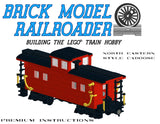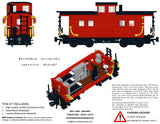Northeastern Caboose Premium Instructions
Northeastern Caboose Premium Instruction Kit
The Northeastern caboose design was created by the Reading Company in the early 1920s as a reaction to proposed legislation requiring that cabooses operated on through freights in Pennsylvania be eight-wheeled and at least 24 feet long. The legislation was finally enacted in 1929, with the additional requirement that the caboose center sill be the equivalent of that on a forty-ton freight car. The design would prove to be quite popular outside of the Reading, with many other nearby railroads adopting the design for their own use. Over the years many Northeastern Cabooses changed hands and the number of railroads who owned them grew. Today, the Northeastern is one of the most popular cabooses in preservation at railroad museum and tourist railroads.
The term "Northeastern caboose" was never used by the railroads that owned cabooses of this design. The name was bestowed by railfans and model railroaders because the majority of the railroads who used them we're located in the Northeastern United States.
Our model of the Northeastern caboose has been careful researched and designed to stay as authentic to the real prototype as possible, and provide the best building experience to you. This is our first model to feature a fully detailed interior.
Our premium instruction kit contains the following:
1 professionally printed instruction book with full color instructions, part list, prototype information, and building tips.
5 Brickarms Mono Pods used in the underside brake details and handrails.
One complete set of Ball Bearing Wheel Sets (4 axles) with black bricks and wheels. Enough to build one car. These wheel sets come fully assembled, with ball bearings pre-installed in new LEGO® Technic bricks, custom sized axles to fit the bearings, washers to prevent wheels from rubbing the bricks and causing excess friction, and new LEGO train wheels.
Why use bearings? Because ball bearings provide excellent free rolling operation. Better than stock LEGO wheel sets. Less resistance means the rail car is easier to pull. And the easier a car is to pull the less strain on locomotives, and the more cars you can pull.
All you need to provide is the LEGO bricks from your own collection. Build the car in the color of your choice, or you can purchase decals to build the car in one of the following authentic railroad paint schemes bellow.
Decals Available for the North Eastern Caboose
Reading "Original Red Scheme"
The first of two paint schemes the Reading used for their Northeastern cabooses. No.90730 was the very first Northeastern caboose built.
Reading "Green and Yellow Scheme"
The second of two paint schemes the Reading used for their Northeastern cabooses. No.94074 was the last Northeastern caboose built by the Reading.
Lehigh Valley “Route of the Black Diamond"
The Lehigh Valley began to build their Northeastern cabooses in 1939. The Lehigh’s NE Cabs wore numerous paint schemes over the years, but the “ROUTE OF THE BLACK DIAMOND” scheme was the first one they used.
Central New Jersey “Coast Guard”
The Central Railroad of New Jersey, while under Reading control, completed their first “northeastern” cabooses in 1942. This paint appearing in the 1970’s became known as the “Coast Guard” scheme because of its resemblance to the markings on US Coast Guard vessels.
Western Maryland “Fast Freight”
The Western Maryland built its first “northeastern” cabooses in 1936. Built in four batches between 1936 and 1940, the WM would eventually own 105 Northeasterns, and this one caboose type would make up the entire WM fleet.
Western Maryland “Speed Letter”
The second WM Northeastern caboose scheme, “Speed Letter” became the WM standard look in the late 1950s.
Western Maryland “Circus Scheme”
Introduced in the 1960s, the Western Maryland’s red, white, and black Caboose scheme has earned the “Circus” nickname by rail fans, perhaps due to it’s similarityis to clown makeup. The WM never officially used the name however.
Western Maryland “Chessie System”
After the C&O-B&O takeover of the Western Maryland in 1973, the Western Maryland Northeastern cabooses began to appear in the bright, Chessie System colors and to wander off-line onto B&O and C&O rails.
CONRAIL
Conrail inherited many Northeastern cabooses when it was formed from several Northeastern US railroads in 1974. Conrail classed these as N4 and N4a, and to the delight of RR historians, stenciled the original railroad initials and caboose number in the upper right hand corner.
Norfolk & Western "Red and White Hamburger"
The Norfolk and Western Railway inherited 15 Northeastern style cabooses when it merged with the Pittsburgh & West Virginia Railway in 1964. The N&W quickly repainted them in it’s standard red caboose paint scheme of the time. Originally numbered 825 to 839, they were renumbered to 500825 to 500839 by the N&W.
Norfolk & Western "Blue and Yellow Hamburger"
The Norfolk and Western Railway’s 15 Northeastern style cabooses were classed C-19. The N&W’s blue caboose paint scheme began appearing in 1966. Originally this scheme called for the roof to be painted blue, later revisions saw some cars with aluminum painted roofs.
New Hope & Ivyland "Bicentennial"
Model by Cale Leiphart, Instructions by Cale Leiphart and Glenn Holland
By purchasing these instructions, you agree not to sell, reproduce, or distribute these instructions. You also agree not to sell or distribute the model made from these instructions.
Brick Model Railroader is a fan publication about LEGO® brand building bricks. This is not a LEGO product. LEGO, and the LEGO logo are trademarks of the LEGO Group. Brick Model Railroader is not affiliated with or endorsed by The LEGO Group.













